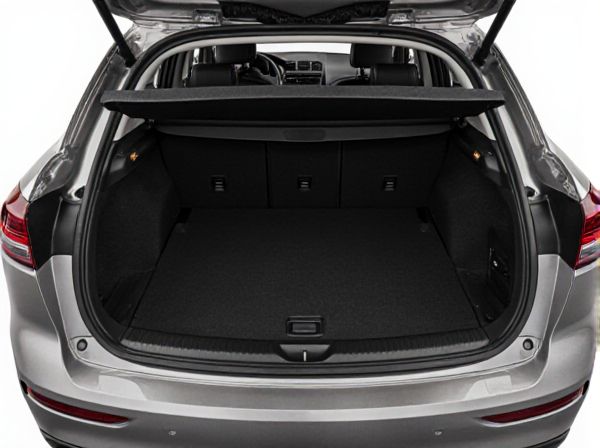
Photo illustration: Hatchback vs Liftback
A hatchback features a rear door that swings upward, providing easy access to the cargo area and maximizing usable space in compact designs. Liftbacks have a sloping rear window integrated into the tailgate, offering a sportier appearance while maintaining practical loading capabilities. Your choice depends on whether you prioritize sharp styling or versatile storage in a compact vehicle.
Table of Comparison
| Feature | Hatchback | Liftback |
|---|---|---|
| Trunk Design | Vertically hinged rear door | Sloped rear door with wider hinge angle |
| Access | Compact opening, easy cargo loading | Larger opening for bulky items |
| Rear Window | Integrated with the door, more upright | Slanted rear window, aerodynamic |
| Cargo Space | Moderate volume, practical for daily use | More spacious, better for larger loads |
| Style | Boxier, traditional hatchback look | Sleeker, near-sedan silhouette |
| Use Case | Ideal for city driving and small families | Suitable for mixed urban and long-distance travel |
Introduction to Hatchbacks and Liftbacks
Hatchbacks feature a rear door that swings upward, combining the cargo area and passenger space into a single, versatile compartment for enhanced practicality. Liftbacks resemble hatchbacks but usually have a more sloped rear window and trunk lid that lifts as one piece, offering a sportier design and slightly different loading experience. Both hatchbacks and liftbacks provide flexible storage options and improved access compared to traditional sedans, appealing to drivers seeking convenience and style.
Defining Hatchback: Key Characteristics
A hatchback is characterized by a rear door that swings upward, creating easy access to the cargo area integrated with the passenger space. Typically featuring a two-box design, hatchbacks provide versatile seating and storage options, making them ideal for urban driving and small families. The compact size and hatchback's rear liftgate combine practicality with sportiness, distinguishing them from other car body styles.
Defining Liftback: Key Features
A liftback is characterized by a rear door that lifts upwards, combining the profile of a sedan with the functionality of a hatchback, offering greater cargo access and versatility. Unlike traditional hatchbacks that tend to have a more upright rear end, liftbacks feature a sloping rear window integrated with the trunk lid, enhancing aerodynamics and aesthetic appeal. Key features include a larger rear opening for loading, a more streamlined silhouette, and often improved rear passenger headroom compared to standard hatchbacks.
Design Differences: Hatchback vs Liftback
Hatchbacks feature a rear door that swings upward, typically with a more vertical rear window and a boxier shape, enhancing cargo space access and urban maneuverability. Liftbacks have a sloping rear window integrated into the rear door, giving a sleeker, coupe-like profile that improves aerodynamics while maintaining practical cargo loading. Design differences primarily affect rear visibility, style, and aerodynamic efficiency, with hatchbacks favored for utility and liftbacks for sportier aesthetics.
Cargo Space and Practicality Comparison
Liftbacks generally offer more cargo space than hatchbacks due to their extended rear design, providing a larger, more accessible loading area. Hatchbacks typically feature a steeper rear door angle, which can limit vertical cargo height but allows for easier access in tight spaces. When evaluating practicality, liftbacks excel in accommodating bulkier items with a flat load floor, whereas hatchbacks prioritize compactness without significantly compromising cargo versatility.
Performance and Driving Experience
Hatchbacks typically offer nimble handling and a compact design, making them ideal for urban driving and quick maneuverability. Liftbacks, with their extended rear roofline, often provide better aerodynamics, which can enhance high-speed stability and fuel efficiency. Both body styles focus on driver engagement, but liftbacks tend to deliver a more refined ride due to their aerodynamic advantages.
Fuel Efficiency and Aerodynamics
Hatchbacks typically offer better fuel efficiency due to their compact size and lighter weight, reducing overall drag and improving miles per gallon. Liftbacks feature a sloping rear roofline that enhances aerodynamic performance by minimizing air resistance, contributing to smoother airflow and potentially improved high-speed fuel economy. Both designs balance practicality and efficiency, with hatchbacks excelling in urban fuel savings and liftbacks optimizing aerodynamics for highway driving.
Market Availability and Popular Models
Hatchbacks dominate urban markets due to their compact size and practicality, with popular models including the Volkswagen Golf, Ford Fiesta, and Honda Fit available globally. Liftbacks, featuring a sloping rear hatch design, are favored in regions like Europe and Asia, with notable models such as the Toyota Corolla Liftback and Hyundai Elantra GT offering a sportier aesthetic and enhanced cargo access. Market availability varies, with hatchbacks widely sold across all segments, while liftbacks maintain a niche presence primarily in mid-size and compact categories.
Pros and Cons of Hatchbacks and Liftbacks
Hatchbacks offer compact dimensions and easy access to the cargo area through a rear door that includes the window, making them ideal for urban driving and efficient parking, but their limited rear headroom and smaller cargo volume may restrict passenger comfort and storage. Liftbacks provide a sleeker, coupe-like design with a more spacious cargo area accessible via a sloping rear hatch, enhancing aerodynamics and style, though they often come at a higher cost and can have slightly reduced rear visibility compared to hatchbacks. Choosing between hatchbacks and liftbacks depends on priorities like practicality, aesthetics, and budget constraints.
Choosing the Right Option: Hatchback or Liftback?
Choosing between a hatchback and a liftback depends on your priorities for cargo space and design. Hatchbacks typically offer a more upright rear window and a smaller tailgate, maximizing versatility in compact city cars like the Volkswagen Golf or Ford Fiesta. Liftbacks feature a sloping rear hatch that integrates the rear window, providing a sleeker profile and easier access to larger items, as seen in models like the Toyota Prius or Mazda3, making them ideal for those seeking style with practicality.
 caratoz.com
caratoz.com